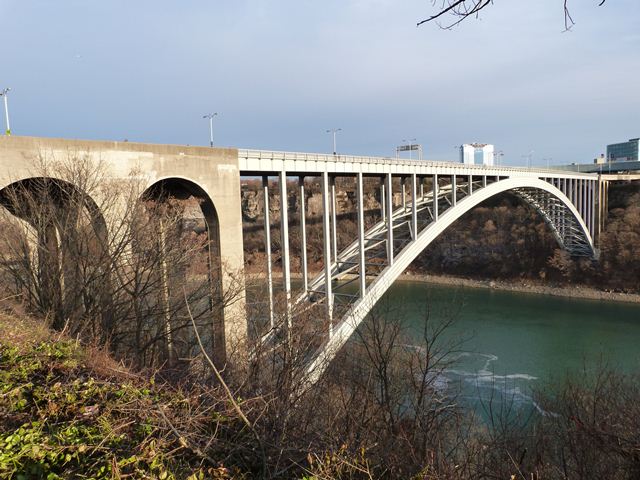We Recommend:
Bach Steel - Experts at historic truss bridge restoration.
Rainbow Bridge

Primary Photographer(s): Nathan Holth
Bridge Documented: December 24, 2012
Roberts Street (KH-420) and Niagara Street (NY 955A) Over Niagara River and River Road
Niagara Falls: Niagara Region, Ontario and Niagara County, New York: Canada and United States
Metal Hingeless Solid Ribbed Deck Arch, Fixed and Approach Spans: Concrete Closed Spandrel Deck Arch, Fixed
1941 By Builder/Contractor: Bethlehem Steel Company of Bethlehem, Pennsylvania and Engineer/Design: Waddell and Hardesty of New York, New York
Not Available or Not Applicable
950.0 Feet (289.6 Meters)
1,444.0 Feet (440.1 Meters)
48 Feet (14.63 Meters)
1 Main Span(s) and 10 Approach Span(s)
5068199

View Information About HSR Ratings
Bridge Documentation
View Archived National Bridge Inventory Report - Has Additional Details and Evaluation
View Historical Article About This Bridge
This bridge is located next to Niagara Falls and as such is a bridge that is seen and photographed by many people, largely because it happens to be where tourists are already visiting the Niagara Falls. However, the bridge itself has a great deal of heritage significance. The bridge is a hingeless steel arch, and when it was first built was reportedly the longest hingeless steel arch ever constructed. The bridge's steel is composed of built-up beams that are riveted together. The bridge appears to retain good historic integrity with no major alterations to the superstructure noted. The bridge's solid rib arch and minimal bracing give this bridge an appearance that is quite modern in comparison to other bridges built during this time.
The bridge also includes a series of concrete arch approach spans which in addition to the obvious function they provide as approach spans also visually compliment the longer main arch span and present a pleasing contrast of steel and concrete. These concrete arch spans have an unusual appearance when viewed up close due to the forms that were used to pour the concrete. Most concrete on old bridges usually does display the texture of the boards that were used as forms for pouring the concrete. However with this bridge, it appears that the boards or planks were either very narrow or were turned sideways, and also there appears to have been enough gap between each plank to allow more concrete to seep through than in most concrete work the concrete as seen today has an unusually striking ribbed appearance and texture to it.
The Rainbow Bridge is the latest of a series of bridges at this location. Earlier bridges included the Upper Steel Arch Bridge, whose destruction by ice accelerated the plans to build the Rainbow Bridge, which had already been in the works anyway. The skewbacks for the Upper Steel Arch Bridge are still visible just south of the Rainbow Bridge. The Upper Steel Arch Bridge had been a replacement for a suspension bridge at this location.
The Rainbow Bridge and the Lewiston Queenston Bridge: Similar Yet With Striking Differences
The Rainbow Bridge and the Lewiston Queenston Bridge are often compared to each other and the newer Lewiston Queenston Bridge is often described as a replica of the Rainbow Bridge. While the Lewiston Queenston Bridge did apparently use some of the designs from the Rainbow Bridge and its main arch span from a distance looks nearly identical to the Rainbow Bridge, many differences are worth noting between the two bridges. Examining these differences also reveals several interesting facts about each bridge.
The Lewiston Queenston Bridge has riveted deck plate girder approach spans, while the Rainbow Bridge has concrete arch approach spans. The bracing the for the older Rainbow Bridge has built-up beams with v-lacing, which was typical for the period in which it was built. The newer Lewiston Queenston Bridge also has built-up beams for the bracing, but in contrast these beams lack v-lacing and instead uses plate with holes in place of the v-lacing, which in turn was typical for this bridge's period of construction. The Lewiston Queenston Bridge and Rainbow Bridges were also erected using two completely different methods. The Rainbow Bridge was erected with the assistance of arch tiebacks which were temporary towers with stays that held the arch in place until it was completed and able to support itself. The Lewiston Queenston Bridge on the other hand was erected with the use of falsework bents that sloped away from the edges of the waterway up to the arch to hold the arch up from below until it was able to support itself.
![]()
Photo Galleries and Videos: Rainbow Bridge
Bridge Photo-Documentation
Original / Full Size PhotosA collection of overview and detail photos. This gallery offers photos in the highest available resolution and file size in a touch-friendly popup viewer.
Alternatively, Browse Without Using Viewer
![]()
Bridge Photo-Documentation
Mobile Optimized PhotosA collection of overview and detail photos. This gallery features data-friendly, fast-loading photos in a touch-friendly popup viewer.
Alternatively, Browse Without Using Viewer
![]()
Maps and Links: Rainbow Bridge
Coordinates (Latitude, Longitude):
Search For Additional Bridge Listings:
Additional Maps:
Google Streetview (If Available)
GeoHack (Additional Links and Coordinates)
Apple Maps (Via DuckDuckGo Search)
Apple Maps (Apple devices only)
Android: Open Location In Your Map or GPS App
Flickr Gallery (Find Nearby Photos)
Wikimedia Commons (Find Nearby Photos)
Directions Via Sygic For Android
Directions Via Sygic For iOS and Android Dolphin Browser



